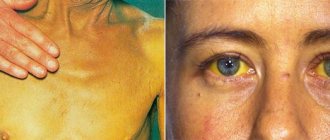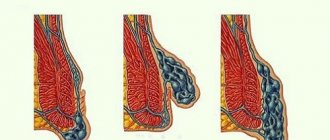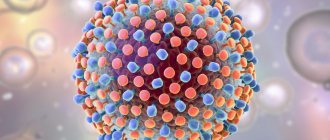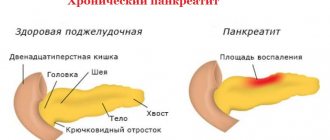What is cirrhosis of the liver?
Liver cirrhosis is an extensive damage to the organ, in which tissue death occurs and is gradually replaced by fibrous fibers. As a result of replacement, nodes of different sizes are formed, radically changing the structure of the liver. The result is a gradual decrease in the functionality of the organ up to complete loss of performance. This leads to a deterioration in the patient’s quality of life and his further death.
It is the liver that cleanses the body of harmful substances, synthesizes fats, carbohydrates, proteins, participates in digestion, produces albumin, etc. Therefore, damage to the liver lobules, consisting of hepatocytes, and their degeneration is a dangerous disease for the body of both men and women .
This disease is widespread throughout the world. According to the latest data, up to 300 thousand people die from this pathology every year, and the mortality rate is steadily increasing. Despite all the advances in medicine, over the past 10 years the incidence of death from cirrhosis has increased by an impressive 12%. In addition, the same percentage of people with chronic alcohol addiction have a history of the disease, but it is asymptomatic.
The pathology is diagnosed more often in men than in women. There are no strict age limits, but the disease predominantly affects people aged 40 years and older.
How long can you live with cirrhosis of the liver?
The disease has a different prognosis. With adequate treatment, which was started in a timely manner, the progression of the pathological process can be stopped. The presence of concomitant diseases, complications, a person’s lifestyle, and the stage of cirrhosis also play a role.
With preserved functional capabilities of hepatocytes, if a person reconsiders his lifestyle and adheres to the therapeutic regimen prescribed by a doctor, survival rate for seven or more years is 50% of the total number of patients. Such a favorable prognosis is appropriate for the compensated form of the disease.
In the subcompensated form, the average life expectancy is about 5 years. This is due to the fact that hepatocytes are gradually depleted and their number becomes insufficient for the normal functioning of the organ.
Among patients at the stage of decompensation, no more than 40% of people live for three years. This is associated with the development of serious complications that are often incompatible with life.
In addition, there are specially developed systems for calculating the prognosis for survival in cirrhosis according to certain criteria. Among these are the Child-Pugh prognostic system, the Cox proportional hazard model and others. All of them are based on certain indicators of the health of a person with cirrhosis (the etiology of the disease, the effectiveness of treatment, the presence of jaundice, neurological disorders, ascites, dilation of the esophageal veins, etc.) and allow a more or less correct prognosis to be made in each specific case.
How long do people live with cirrhosis of the liver?
According to world statistics, the life expectancy of patients with compensated liver cirrhosis exceeds 10 years. With decompensated cirrhosis, 40% of patients die in the first three years from diagnosis. Patients with hepatic encephalopathy can live no more than 1 year.
The most effective method to increase the prognosis for liver cirrhosis is to modify the patient’s lifestyle: giving up bad habits, normalizing eating behavior, eating plenty of vegetables and fruits, maintaining healthy skin, undergoing regular medical examinations and following the treatment recommendations of the attending physician.
(Visited 9 103 times, 3 visits today)
The first signs of liver cirrhosis
It is not always possible to suspect the presence of a disease based on early signs, since in 20% of cases it is latent and does not manifest itself in any way. Moreover, in another 20% of patients, pathology is discovered only after death. However, in the remaining 60% the disease still manifests itself.
Therefore, among the early symptoms indicating cirrhosis, the following can be noted:
- Periodically occurring pain localized in the right hypochondrium. They tend to increase after intense physical activity or after taking fatty and fried foods, alcoholic beverages;
- A feeling of bitterness and dryness appears in the mouth, especially often in the morning;
- A person may be bothered by periodic stool disorders, increased flatulence;
- The patient loses some weight, becomes irritable, and gets tired faster;
- Some forms of the disease, for example, postnecrotic cirrhosis, manifest themselves in the form of jaundice already in the early stages of development.
In some cases, the disease manifests itself acutely and there are no early signs.
Other symptoms of liver cirrhosis
The main symptoms of the disease increase as it progresses:
- Pain in the right side intensifies due to the expansion of the liver capsule, and may have the nature of colic. With concomitant hypokinetic dyskinesia, they increase, become aching, and are accompanied by a feeling of heaviness;
- The patient experiences attacks of nausea, often accompanied by vomiting. Vomit may contain blood, which indicates bleeding from the veins of the stomach and esophagus;
- Due to the accumulation of excess bile acids in the blood, the patient experiences itchy skin;
- There is a loss of body weight, up to exhaustion;
- Decreased muscle tone, atrophy;
- The skin acquires a jaundiced tint and peels. Severe jaundice is a sign of the final stage of the disease. First, the sclera of the eyes, mucous membranes of the oral cavity, palms and soles, and then the entire body are painted. This is due to the inability of hepatocytes to metabolize bilirubin;
- The appearance of xanthelasmas - spots with a lipid component, localized mainly in the area of the upper eyelids;
- The fingers thicken at the ends, take on the shape of drumsticks, the skin around the nail holes turns red;
- The joints swell and begin to ache;
- The veins in the abdomen dilate;
- Doctors find spider veins on the upper body. A characteristic feature of cirrhosis is that telangiectasias never form below the umbilical zone. During the acute stage of the disease, the number of stars becomes larger and they look very noticeable;
- The edge of the nose and the corners of the eyes are covered with angiomas;
- Redness of the palms, less often of the feet;
- The tongue swells and becomes brightly colored;
- In men, the mammary glands begin to grow, and the functions of the genital organs atrophy. Secondary sexual characteristics decrease: pubic and armpit hair falls out;
- Ascites is one of the late complications of cirrhosis, characterized by the accumulation of fluid in the abdominal cavity;
- The face takes on an unhealthy hue, the cheekbones clearly stand out, the salivary glands swell, the capillaries on the face expand, giving it a red color;
- The limbs become thin, the stomach, on the contrary, protrudes forward;
- Bleeding from the nose often occurs;
- The spleen enlarges;
- Obvious disturbances in nervous activity appear: the patient suffers from insomnia and deterioration of memory function. There is a tremor of the limbs, an indifferent attitude to what is happening around.
Symptoms of the disease
The first symptoms of liver cirrhosis in men and women may appear when the disease begins to progress and enters a deadly phase. Almost every fifth person does not show signs of the disease at all.
The following symptoms of cirrhosis should alert you:
- bleeding gums;
- decreased performance, constant feeling of fatigue;
- feeling of fullness in the abdomen;
- tolerable pain in the right hypochondrium after alcohol or physical activity, lifting heavy objects.
After some time, other signs appear:
- the organ increases in size;
- due to high bilirubin, yellowing appears on the skin and sclera of the eyes;
- a large amount of fluid accumulates in the abdominal cavity - ascites progresses;
- the appearance of the veins changes: stars appear, the veins approach the skin. This is most often seen on the abdomen;
- body weight decreases with a normal diet;
- the tongue swells, becomes crimson, the tips of the fingers thicken (symptom “drumsticks”);
- nausea and vomiting with blood due to intestinal bleeding, etc.
At the last stage of cirrhosis, the patient suffers from severe abdominal pain. At first they appear only after eating or physical activity, but over time they are observed even during rest.
Causes of liver cirrhosis
Among the main reasons leading to the development of the disease are:
- Viral hepatitis, which, according to various estimates, leads to the formation of liver pathology in 10-24% of cases. The disease results in such types of hepatitis as, , and the recently discovered hepatitis G;
- Drinking large doses of alcohol for 10 years or more. There is no dependence on a specific type of drink; the fundamental factor is the presence of ethyl alcohol in it and its regular intake into the body;
- Disturbances in the functioning of the immune system. Many autoimmune diseases lead to the development of cirrhosis;
- Various diseases of the biliary tract, including extrahepatic obstruction, cholelithiasis and primary sclerosing cholangitis;
- Portal hypertension;
- Venous congestion in the liver or Budd-Chiari syndrome;
- Diseases transmitted by inheritance, in particular, genetically determined metabolic disorders (anomalies of glycogen accumulation, Wilson-Konovalov disease, deficiency of α1-antitrypsin and galactose-1-phosphate-uridyltransferase);
- Poisoning with chemicals that have a toxic effect on the body. Among such substances, industrial poisons, salts of heavy metals, aflatoxins and mushroom poisons are especially harmful to the liver;
- Long-term use of medications, including Iprazide, anabolic steroids, Isoniazid, androgens, Methyldopa, Inderal, Methotrexate and some others;
- The rare Osler-Rendu disease can also cause cirrhosis.
In addition, it is worth mentioning separately about cryptogenic cirrhosis, the causes of which remain unclear. It occurs in the range from 12 to 40% of cases. Provoking factors for the formation of scar tissue can be systematic malnutrition, infectious diseases, syphilis (which can cause cirrhosis in newborns). The combined influence of etiological factors, for example, a combination of hepatitis and alcoholism, significantly increases the risk of developing the disease.
Causes
Why does liver cirrhosis develop, and what is it? Liver cirrhosis is a late stage of various inflammatory diseases of the liver (hepatitis) and some other organs (for example, the heart - heart failure).
As a result of damage and inflammation of liver cells, some of them die. Connective tissue grows in place of dead liver cells. Connective tissue surrounds the remaining liver cells, but cannot perform their functions. The remaining liver cells begin to rapidly divide, forming islands of normal liver tissue, which are surrounded by connective tissue. The structure of the liver is disrupted, and its functions are not fully performed. As a result of loss of liver function, liver failure develops.
All the causes of cirrhosis have not been established. But it has been proven that most often the death of liver cells occurs as a result of:
- long-term exposure to such diseases and processes:
- alcohol addiction;
- viral hepatitis (especially B and C);
- autoimmune mechanisms;
- inborn errors of metabolism: Wilson-Konovalov disease, hemochromatosis, alpha-1-antitrypsin deficiency.
- exposure to toxic chemicals and hepatotoxic medications;
- blockage of the bile ducts;
- stagnation of venous blood in the liver associated with heart disease or veno-occlusive liver disease.
If it is impossible to establish the cause of the disease, they speak of cryptogenic cirrhosis. Thus, cirrhosis of the liver is a multifactorial chronic disease, and, as we see, there are quite a lot of causal sources from which cirrhosis of the liver occurs.
Stages of liver cirrhosis
The disease goes through several stages of development, each of which has certain clinical symptoms. Not only the person’s condition, but also the therapy he requires will depend on how much the pathology has progressed.
Stage 1 of liver cirrhosis
At this stage of development, the disease practically does not manifest itself at all. If it is detected at this time, then it is still quite possible to compensate for the deficiency of hepatocytes with the help of medications. Therefore, doctors call the initial stage of the disease compensatory.
Despite the fact that the patient does not observe any clinical signs, changes in the organ have already begun. If timely treatment is not started, cirrhosis will progress rapidly and, after a short time, the liver will no longer be able to cope with its functions in full. As for laboratory indicators, the level of bilirubin in the blood increases, and the prothrombic index can drop to 60. But at the same time, the person feels absolutely healthy. He may only occasionally be bothered by pain in the right hypochondrium.
It is precisely because cirrhosis can be suspected based on laboratory parameters that regular preventive examinations by a doctor are necessary.
Stage 2 liver cirrhosis
The next stage is called subcompensated. Based on the name, it can be understood that there is a more pronounced decrease in the functionality of the organ, which is due to an increase in the number of dead hepatocytes.
At this stage, a person is able to notice that something is happening to his body. He begins to suffer from weakness, apathy, decreased performance, nausea, weight loss and other early symptoms of the disease. In men, already at this stage the first signs of gynecomastia appear.
As for laboratory indicators, the albumin level begins to fall, and the prothrombic index can reach 40. However, if treatment is started in a timely manner, it is still possible to transfer this stage to the compensation stage. That is, if medications are taken correctly, the diseased organ will be able to function without complications for human health.
Stage 3 liver cirrhosis
Stage 3 of the disease is dangerous because there are critically few functioning hepatocytes. This causes the progression of liver failure and an increase in symptoms of the disease. The skin takes on a jaundiced tint, and abdominal pain worries the person more and more. Often it is at this stage that ascites develops, which can no longer go away on its own.
Albumin levels and prothrombic index drop to critical values.
Treatment at this stage is no longer effective, although there is still a chance that medications will help cope with the disease. The patient should be in a hospital under the supervision of doctors, since this stage is characterized by severe metabolic disorders.
The danger is posed by complications of the disease, which may well cause death. Among the most dangerous are hepatic coma, liver cancer, internal bleeding, peritonitis and pneumonia. This stage is called terminal.
Stage 4 liver cirrhosis
The final stage of the disease is characterized by the fact that the tissues of the organ are so damaged that they are no longer able to cope with the tasks assigned to them. The pain is very severe, the patient is prescribed constant use of strong painkillers.
It is impossible to stop the progression of the disease at this stage. The prognosis is usually unfavorable, and without a liver transplant the patient dies from severe complications.
Consequences and complications of liver cirrhosis
The disease is dangerous for humans due to the development of serious complications, which most often cause death:
- The development of ascites, that is, the accumulation of fluid in the abdominal cavity;
- The occurrence of peritonitis, that is, inflammation of the peritoneum;
- Varicose veins passing through the esophagus or stomach, and, as a result, the development of internal bleeding. Among the symptoms that characterize the onset of such bleeding are the occurrence of vomiting with blood, staining of stool in black, a drop in blood pressure and a pronounced increase in heart rate;
- Hepatic encephalopathy;
- loss or confusion;
- The development of a malignant tumor (carcinoma), which is difficult to treat and progresses rapidly;
- Hepatorenal syndrome, characterized by renal failure;
- A drop in blood oxygen levels or hepatopulmonary syndrome;
- Hepatic gastropathy – disorders of the stomach;
- Hepatic colopathy – intestinal dysfunction;
- The impossibility of procreation is infertility.
Complications
As liver cirrhosis progresses, the following consequences are possible:
- hepatic coma;
- bleeding from varicose veins of the esophagus;
- thrombosis in the portal vein system;
- hepatorenal syndrome;
- formation of liver cancer - hepatocellular carcinoma;
- infectious complications - pneumonia, “spontaneous” peritonitis with ascites, sepsis.
Diagnosis of liver cirrhosis
A doctor cannot make such a serious diagnosis without conducting a comprehensive examination of the patient. First of all, the patient will need to donate blood for a biochemical analysis. If the results alert the doctor, he will send the patient for further diagnostics.
A coagulogram will show whether there are any disorders of the blood coagulation system. A general blood test will reveal the level of hemoglobin, which is usually low in patients with cirrhosis. Anemia is often diagnosed. In addition, the number of leukocytes and platelets decreases markedly.
To exclude or confirm the viral nature of the disease, the patient must be tested to detect hepatitis - A, B, C, D and G. A stool test for occult blood will help determine the presence of hidden bleeding in the gastrointestinal tract.
Kidney failure is determined by electrolyte and creatine levels. If there is a suspicion of liver cancer, the patient will need to donate blood for alpha-fetoprotein.
In addition, an ultrasound scan of all abdominal organs and portal vessels is necessary. It is important to determine the presence of ascites and enlarged spleen.
Using esophagogastroduodenoscopy, the doctor will make a conclusion about the existing varicose veins of the esophagus and stomach.
A liver biopsy will help clarify the diagnosis and determine the stage of development of the disease. If necessary, the doctor sends the patient for liver scintigraphy or CT.
Biochemical blood parameters in liver cirrhosis
As a rule, an experienced doctor is able to suspect a disease based on only one test - blood biochemistry. Indicators for cirrhosis change according to a certain pattern: there is an increase in the level of bilirubin, liver transaminases (not higher than 40 IU), alkaline phosphatase (should not be higher than 140 IU), globulins, prothrombin time, haptoglobin, and specific liver enzymes. Against this background, there is a fall in albumin (less than 40 g per liter), prothrombin, urea (less than 2.5 µmol), cholesterol (less than 2 µmol).
An increase in the level of bilirubin in cirrhosis is especially indicative, since this substance is a breakdown product of red blood cells and hemoglobin and must be processed by the liver. When the functionality of an organ is impaired, bilirubin begins to circulate in excess in the blood. This leads to a yellow-green coloration of stool, as well as yellowing of the skin, mucous membranes and whites of the eyes. Therefore, total bilirubin should normally not exceed 20.5 µmol per liter, free - 17.1, and bound - 4.3. As the disease progresses, these numbers can increase several times.
Diagnostics
At the initial stage, it is almost impossible to visually diagnose liver cirrhosis. Visible symptoms, such as yellowing of the sclera of the eyes and skin, and an enlarged abdomen, appear somewhat later. Therefore, the doctor prescribes laboratory tests that help make an accurate diagnosis.
Examinations and tests:
- Blood test (general). Needed to detect an increased erythrocyte sedimentation rate and an increase in leukocytes.
- Urinalysis (general). Detects protein and red blood cells in urine.
- Blood chemistry. This analysis is one of the most important and revealing, since it allows you to detect the level of bilirubin, enzymes and albumin. In addition, it determines the degree of development of the disease.
- Ultrasound. Ultrasound examination can detect the location of scar tissue.
- Biopsy. Tissue from the affected organ is collected for histological examination. As a result, the doctor can obtain information such as the condition of blood vessels, changes in the structure of connective tissue, the appearance of nodes and scars.
Reference! Additionally, if cirrhosis is suspected, tests such as scintigraphy, CT (computed tomography), and radionuclide testing may be prescribed.
Is it possible to cure cirrhosis of the liver?
Most patients, having heard a terrible diagnosis from a doctor, quite reasonably ask the question: is it possible to completely get rid of the disease? Modern medicine does not have such capabilities. The only radical treatment option is to transplant a donor organ. However, liver transplantation is not suitable for every patient and costs a lot of money.
However, do not despair, because if the disease was detected in the early stages, then it is quite possible to stop its progression thanks to adequate therapy. If cirrhosis is detected in the later stages, doctors may be able to somewhat slow down the progression of the disease and delay the onset of complications.
Scientists are still trying to develop a medicine that can cure cirrhosis. But so far, official medicine has not announced a single remedy that can completely cure a person. However, it is quite possible to transfer cirrhosis into the category of controlled chronic diseases.
How to treat liver cirrhosis?
As for treatment, it is selected strictly individually in each specific case. However, there are certain criteria applicable to the treatment of the disease. Thus, the compensated stage of cirrhosis needs to eliminate the main cause that led to the development of the pathology. The patient is prescribed medications for the treatment of hepatitis, attempts are made to relieve his alcohol addiction, etc. In addition, it is necessary to reduce the risk of developing complications that can aggravate the course of the disease.
The patient must adhere to a diet with an optimal content of proteins and carbohydrates. It is important to exclude any type of alcohol and harmful foods. All medications are used only as prescribed by a doctor; their use must be determined by vital necessity.
As a rule, physiotherapeutic procedures, physical activity, and heat treatment are not recommended for the patient. No traditional medicine should be used without prior consultation with your doctor.
If a patient seeks help at the stage of decompensation, he is treated in a hospital setting, which is due to the high risk of complications. The main goal pursued by any doctor during this period is to stop the progression of the disease. For this purpose, medications are used that are selected according to an individual regimen and depend on the form of cirrhosis.
It is possible to prescribe hepatoprotectors, ursodeoxycholic acid preparations, nitrates and beta-blockers.
Liver transplant for cirrhosis
The only radical treatment method is transplantation of the damaged organ. The operation is carried out if the liver is not able to cope with the functions assigned to it, and conservative therapy is powerless.
A donor organ is removed from a deceased person who, during his lifetime, did not write a waiver of such removal, although the laws differ in different countries. Since the operation is quite complex and subsequently requires lifelong use of drugs that suppress the immune system, it is not performed in the early stages of cirrhosis.
Indications for transplantation include the following:
- Internal bleeding that cannot be controlled with medication;
- Ascites not responding to treatment;
- Albumin drops below 30 g;
- Increase in prothrombin time above 17 s.
These indicators are a direct threat not only to the health, but also to the life of the patient, and therefore require organ transplantation. However, the list of contraindications is no shorter, including the presence of an infectious process, severe pathologies of the heart and lungs, any malignant tumors with metastases, brain damage, age over 60 years or under 2 years, obesity, etc.
The operation itself lasts at least 8 hours and consists of removing the damaged organ and transplanting a healthy one. It is possible that only part of the liver will be transplanted from the donor. As for the prognosis after transplantation, it is quite favorable, although certain risks still exist, for example, liver rejection, hepatic artery thrombosis and others. The survival rate for the next five years is 75%, this is a good indicator given the severity of the disease, with about 40% of people living with a foreign organ for more than 20 years.
On the subject: Treatment of liver cirrhosis with folk remedies
Is there any disability for cirrhosis of the liver?
Registration of disability for this disease is possible. The group that will be assigned to a person depends on the severity of cirrhosis and its stage. As a rule, when diagnosing the first stage of the disease, the patient is assigned to the 3rd disability group. If cirrhosis has reached the stage of decompensation, then the person will be assigned disability group 2. When the disease is in terminal stages, the person is assigned to the first group.
To receive help from the state, the patient will need to undergo a special commission, to which he will be referred by the treating doctor.
On the subject: Diet for liver cirrhosis - what can you eat and what can you not?










